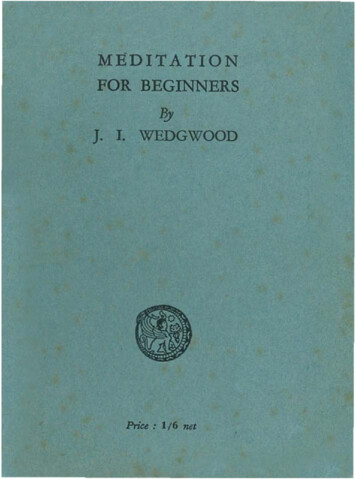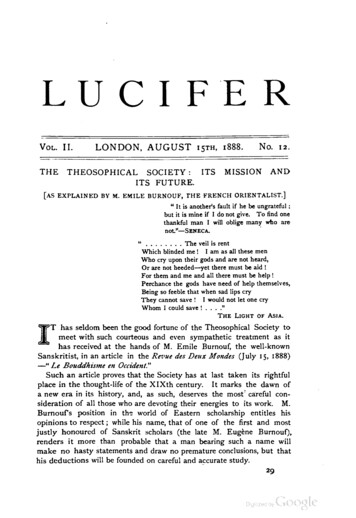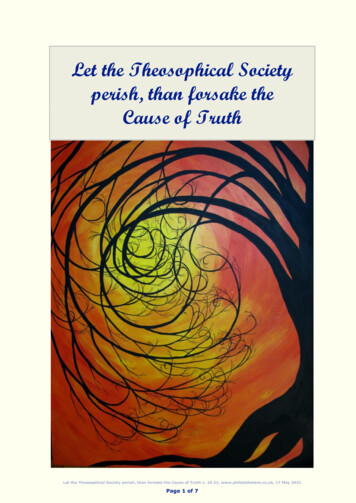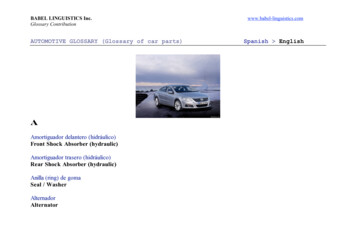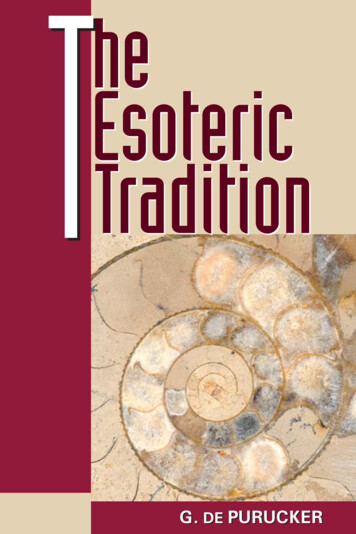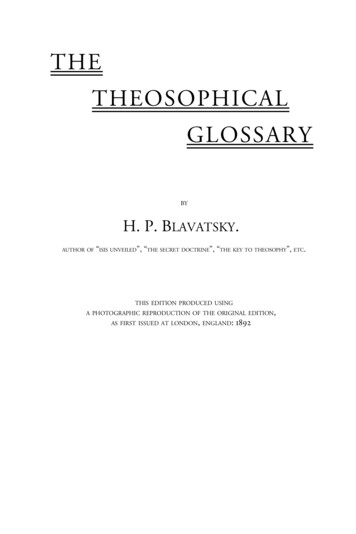
Transcription
THETHEOSOPHICALGLOSSARYBYH. P. BLAVATSKY.AUTHOR OF “ISIS UNVEILED”, “THE SECRET DOCTRINE”, “THE KEY TO THEOSOPHY”, ETC.THIS EDITION PRODUCED USINGA PHOTOGRAPHIC REPRODUCTION OF THE ORIGINAL EDITION,AS FIRST ISSUED AT LONDON, ENGLAND:
Editorial NoteUnder Crux Ansata, the first symbol, which in the original editionshowed a tau, thus, was edited to show the crux ansata, thus. Thesame change is found in the second edition, published in . No otherchanges were deliberately made to the original in the transcription of thisedition, however, due to human error in proof-reading we cannotguarantee that minor errors do not exist.ISBN: 978-1484974070
PREFACE.The Theosophical Glossary labours under the disadvantage of beingan almost entirely posthumous work, of which the author only sawthe first thirty-two pages in proof. This is all the more regrettable, forH.P.B., as was her wont, was adding considerably to her originalcopy, and would no doubt have increased the volume far beyond itspresent limits, and so have thrown light on many obscure terms thatare not included in the present Glossary, and more important still,have furnished us with a sketch of the lives and teachings of the mostfamous Adepts of the East and West.The Theosophical Glossary purposes to give information on theprincipal Sanskrit, Pahlavi, Tibetan, Pâli, Chaldean, Persian,Scandinavian, Hebrew, Greek, Latin, Kabalistic and Gnostic words,and Occult terms generally used in Theosophical literature, andprincipally to be found in Isis Unveiled, Esoteric Buddhism, The SecretDoctrine, The Key to Theosophy, etc.; and in the monthly magazines,The Theosophist, Lucifer and The Path, etc., and other publications ofthe Theosophical Society. The articles marked [w. w. w.] whichexplain words found in the Kabalah, or which illustrate Rosicrucianor Hermetic doctrines, were contributed at the special request ofH.P.B. by Bro. W. W. Westcott, M.B., P.M. and P.Z., who is theSecretary General of the Rosicrucian Society, and Præmonstrator ofthe Kabalah to the Hermetic Order of the G.D.H.P.B. desired also to express her special indebtedness, as far as thetabulation of facts is concerned, to the Sanskrit-Chinese Dictionary ofEitel, The Hindû Classical Dictionary of Dowson, The Vishnu Purânaof Wilson, and the Royal Masonic Cyclopædia of Kenneth Mackenzie.As the undersigned can make no pretension to the elaborate andextraordinary scholarship requisite for the editing of the multifariousand polyglot contents of H.P.B.’s last contribution to Theosophicalliterature, there must necessarily be mistakes of transliteration, etc.,which specialists in scholarship will at once detect. Meanwhile,however, as nearly every Orientalist has his own system, varyingtransliterations may be excused in the present work, and not be setdown entirely to the “Karma” of the editor.G. R. S. MEADLONDON, January, .
THEOSOPHICALGLOSSARY.AA.—The first letter in all the world-alphabets save a few, such for instanceas the Mongolian, the Japanese, the Tibetan, the Ethiopian, etc. It is aletter of great mystic power and “magic virtue” with those who haveadopted it, and with whom its numerical value is one. It is the Aleph of theHebrews, symbolized by the Ox or Bull; the Alpha of the Greeks, the oneand the first; the Az of the Slavonians, signifying the pronoun “I”(referring to the “I am that I am”). Even in Astrology, Taurus (the Ox orBull or the Aleph) is the first of the Zodiacal signs, its colour being whiteand yellow. The sacred Aleph acquires a still more marked sanctity withthe Christian Kabalists when they learn that this letter typifies the Trinityin Unity, as it is composed of two Yods, one upright, the other reversedwith a slanting bar or nexus, thus— א . Kenneth R. H. Mackenzie statesthat “the St. Andrew cross is occultly connected therewith”. The divinename, the first in the series corresponding with Aleph, is AêHêIêH orAhih when vowelless, and this is a Sanskrit root.Aahla (Eg.). One of the divisions of the Kerneter or infernal regions, orAmenti; the word means the “Field of Peace”.Aanroo (Eg.). The second division of Amenti. The celestial field ofAanroo is encircled by an iron wall. The field is covered with wheat, andthe “Defunct” are represented gleaning it, for the “Master of Eternity”;some stalks being three, others five, and the highest seven cubits high.Those who reached the last two numbers entered the state of bliss (whichis called in Theosophy Devachan); the disembodied spirits whose harvestwas but three cubits high went into lower regions (Kâmaloka). Wheat waswith the Egyptians the symbol of the Law of retribution or Karma. Thecubits had reference to the seven, five and three human “principles”.Aaron (Heb.). The elder brother of Moses and the first Initiate of the
2THEOSOPHICALHebrew Lawgiver. The name means the Illuminated, or the Enlightened.Aaron thus heads the line, or Hierarchy, of the initiated Nabim, or Seers.Ab (Heb.). The eleventh month of the Hebrew civil year; the fifth of thesacred year beginning in July. [w. w. w.]Abaddon (Heb.). An angel of Hell, corresponding to the GreekApollyon.Abatur (Gn.). In the Nazarene system the “Ancient of Days”, AntiquusAltus, the Father of the Demiurgus of the Universe, is called the ThirdLife or “Abatur”. He corresponds to the Third “Logos” in the SecretDoctrine. (See Codex Nazaræus)Abba Amona (Heb.). Lit., “Father-Mother”; the occult names of the twohigher Sephiroth, Chokmah and Binah, of the upper triad, the apex ofwhich is Sephira or Kether. From this triad issues the lower septenary ofthe Sephirothal Tree.Abhâmsi (Sk.). A mystic name of the “four orders of beings” which are,Gods, Demons, Pitris and Men. Orientalists somehow connect the namewith “waters”, but esoteric philosophy connects its symbolism with Âkâsa—the ethereal “waters of space”, since it is on the bosom and on the sevenplanes of “space” that the “four orders of (lower) beings” and the threehigher Orders of Spiritual Beings are born. (See Secret Doctrine I. p. ,and “Ambhâmsi”.)Âbhâsvaras (Sk.). The Devas or “Gods” of Light and Sound, the highestof the upper three celestial regions (planes) of the second Dhyâna (q.v.) Aclass of gods sixty-four in number, representing a certain cycle and anoccult number.Abhâva (Sk.). Negation, or non-being of individual objects; thenoumenal substance, or abstract objectivity.Abhaya (Sk.). “Fearlessness”—a son of Dharma; and also a religious lifeof duty. As an adjective, “Fearless,” Abhaya is an epithet given to everyBuddha,Abhayagiri (Sk.). Lit., “Mount Fearless” in Ceylon. It has an ancientVihâra or Monastery in which the well-known Chinese traveller Fa-hienfound , Buddhist priests and ascetics in the year of our era, anda School called Abhayagiri Vâsinah,, “School of the Secret Forest”. Thisphilosophical school was regarded as heretical, as the ascetics studied thedoctrines of both the “greater” and the “smaller” vehicles—or theMahâyâna and the Hînayâna systems and Triyâna or the three successivedegrees of Yoga; just as a certain Brotherhood does now beyond theHimalayas. This proves that the “disciples of Kâtyâyana were and are asunsectarianastheirhumbleadmirerstheTheosophists
GLOSSARY3are now. (See “Sthâvirâh” School.) This was the most mystical of all theschools, and renowned for the number of Arhats it produced. TheBrotherhood of Abhayagiri called themselves the disciples of Kâtyâyana,the favourite Chela of Gautama, the Buddha. Tradition says that owing tobigoted intolerance and persecution, they left Ceylon and passed beyondthe Himalayas, where they have remained ever since.Abhidharma (Sk.). The metaphysical (third) part of Tripitaka, a veryphilosophical Buddhist work by Kâtyâyana.Abhijñâ (Sk.). Six phenomenal (or “supernatural”) gifts whichSâkyamuni Buddha acquired in the night on which he reachedBuddhaship. This is the “fourth” degree of Dhyâna (the seventh inesoteric teachings) which has to be attained by every true Arhat. In China,the initiated Buddhist ascetics reckon six such powers, but in Ceylon theyreckon only five. The first Abhijñâ is Divyachakchus, the instantaneousview of anything one wills to see; the second, is Divyasrotra, the power ofcomprehending any sound whatever, etc., etc.Abhimânim (Sk.). The name of Agni (fire) the “eldest son of Brahmâ”,in other words, the first element or Force produced in the universe at itsevolution (the fire of creative desire). By his wife Swâhâ, Abhimânim hadthree sons (the fires) Pâvaka, Pavamâna and Suchi, and these had “fortyfive sons, who, with the original son of Brahmâ and his three descendants,constitute the forty-nine fires” of Occultism.Abhimanyu (Sk.). A son of Arjuna. He killed Lakshmana,in the greatbattle of the Mahâbhârata on its second day, but was himself killed on thethirteenth.Abhûtarajasas (Sk.). A class of gods or Devas, during the period of thefifth Manvantara.Abib (Heb.) The first Jewish sacred month, begins in March; is alsocalled Nisan.Abiegnus Mons (Lat.). A mystic name, from whence as from a certainmountain, Rosicrucian documents are often found to be issued—“MonteAbiegno”. There is a connection with Mount Meru, and other sacred hills.[w. w. w.]Ab-i-hayat (Pers.). Water of immortality. Supposed to give eternal youthand sempiternal life to him who drinks of it.Abiri (Gr.). See Kabiri, also written Kabeiri, the Mighty Ones, celestials,sons of Zedec the just one, a group of deities worshipped in Phœnicia:they seem to be identical with the Titans, Corybantes, Curetes, Telchinesand Dii Magni of Virgil. [w. w. w.]Ablanathanalba (Gn.). A term similar to “Abracadabra”. It is said by C.W. King to have meant “thou art a father to us”; it reads the same
4THEOSOPHICALfrom either end and was used as a charm in Egypt. (See “Abracadabra”.)Abracadabra (Gn.). This symbolic word first occurs in a medical treatisein verse by Samonicus, who flourished in the reign of the EmperorSeptimus Seveus. Godfrey Higgins says it is from Abra or Abar “God”, inCeltic, and cad “holy”; it was used as a charm, and engraved on Kameas asan amulet. [w. w. w.]Godfrey Higgins was nearly right, as the word “Abracadabra” is a latercorruption of the sacred Gnostic term “Abrasax”, the latter itself being astill earlier corruption of a sacred and ancient Coptic or Egyptian word: amagic formula which meant in its symbolism “Hurt me not”, andaddressed the deity in its hieroglyphics as “Father”. It was generallyattached to an amulet or charm and worn as a Tat (q.v.), on the breastunder the garments.Abraxas or Abrasax (Gn.). Mystic words which have been traced as farback as Basilides, the Pythagorean, of Alexandria, A.D. . He uses Abraxasas a title for Divinity, the supreme of Seven, and as having virtues. InGreek numeration, a. , b. , r. , a. , x. , a. , s. , days ofthe year, solar year, a cycle of divine action. C. W. King, author of TheGnostics, considers the word similar to the Hebrew Shemhamphorasch, aholy word, the extended name of God. An Abraxas Gem usually shows aman’s body with the head of a cock, one arm with a shield, the other witha whip. [w. w. w.]Abraxas is the counterpart of the Hindu Abhimânim (q.v.) and Brahmâcombined. It is these compound and mystic qualities which caused Oliver,the great Masonic authority, to connect the name of Abraxas with that ofAbraham. This was unwarrantable; the virtues and attributes of Abraxas,which are in number, ought to have shown him that the deity wasconnected with the Sun and solar division of the year—nay, that Abraxasis the antitype, and the Sun, the type.Absoluteness. When predicated of the UNIVERSAL PRINCIPLE, it denotes anabstract noun, which is more correct and logical than to apply theadjective “absolute” to that which has neither attributes nor limitations,nor can IT have any.Ab-Soo (Chald.). The mystic name for Space, meaning the dwelling ofAb the “Father”, or the head of the source of the Waters of Knowledge.The lore of the latter is concealed in the invisible space or âkâsic regions.Acacia (Gr.). Innocence; and also a plant used in Freemasonry as asymbol of initiation, immortality, and purity; the tree furnished the sacredShittim wood of the Hebrews. [w. w. w.]Achamôth (Gn.). The name of the second, the inferior Sophia.
GLOSSARY5Esoterically and with the Gnostics, the elder Sophia was the Holy Spirit(female Holy Ghost) or the Sakti of the Unknown, and the Divine Spirit;while Sophia Achamôth is but the personification of the female aspect ofthe creative male Force in nature; also the Astral Light.Achar (Heb.). The Gods over whom (according to the Jews) Jehovah isthe God.Âchâra (Sk.). Personal and social (religious) obligations.Âchârya (Sk.). Spiritual teacher, Guru; as Sankar-âchârya, lit., a “teacherof ethics”. A name generally given to Initiates, etc., and meaning“Master”.Achath (Heb.). The one, the first, feminine; achad being masculine. ATalmudic word applied to Jehovah. It is worthy of note that the Sanskritterm ak means one, ekata being “unity”, Brahmâ being called âk, or eka,the one, the first, whence the Hebrew word and application.Acher (Heb.). The Talmudic name of the Apostle Paul. The Talmudnarrates the story of the four Tanaim, who entered the Garden of Delight,i.e., came to he initiated; Ben Asai, who looked and lost his sight; BenZoma, who looked and lost his reason; Acher, who made depredations inthe garden and failed; and Rabbi Akiba, who alone succeeded. TheKabalists say that Acher is Paul.Acheron (Gr.). One of the rivers of Hades in Greek mythology.Achit (Sk.). Absolute non-intelligence; as Chit is—in contrast—absoluteintelligence.Achyuta (Sk.). That which is not subject to change or fall; the oppositeto Chyuta, “fallen”. A title of Vishnu.Acosmism (Gr.). The precreative period, when there was no Kosmos butChaos alone.Ad (Assyr.). Ad, “the Father”. In Aramean ad means one, and ad-ad “theonly one”.Adah (Assyr.). Borrowed by the Hebrews for the name of their Adah,father of Jubal, etc. But Adah meaning the first, the one, is universalproperty. There are reasons to think that Ak-ad, means the first-born orSon of Ad. Adon was the first “Lord” of Syria. (See Isis Unv. II., pp. , .)Adam (Heb.). In the Kabalah Adam is the “only-begotten”, and meansalso “red earth”. (See “Adam-Adami” in the S.D. II p. .) It is almostidentical with Athamas or Thomas, and is rendered into Greek byDidumos, the “twin”—Adam, “the first”, in chap. of Genesis, beingshown, “male-female.”Adam Kadmon (Heb). Archetypal Man; Humanity. The
6THEOSOPHICAL“Heavenly Man” not fallen into sin; Kabalists refer it to the Ten Sephirothon the plane of human perception. [w. w. w.]In the Kabalah Adam Kadmon is the manifested Logos corresponding toour Third Logos; the Unmanifested being the first paradigmic ideal Man,and symbolizing the Universe in abscondito, or in its “privation” in theAristotelean sense. The First Logos is the “Light of the World”, the Secondand the Third—its gradually deepening shadows.Adamic Earth (Alch.). Called the “true oil of gold” or the “primalelement” in Alchemy. It is but one remove from the pure homogeneouselement.Adbhuta Brâhmana (Sk.). The Brâhmana of miracles; treats of marvels,auguries, and various phenomena.Adbhuta Dharma (Sk.). The “law” of things never heard before. A class ofBuddhist works on miraculous or phenomenal events.Adept (Lat.). Adeptus, “He who has obtained.” In Occultism one who hasreached the stage of Initiation, and become a Master in the science ofEsoteric philosophy.Adharma (Sk.). Unrighteousness, vice, the opposite of Dharma.Adhi (Sk.). Supreme, paramount.Adhi-bhautika duhkha (Sk.). The second of the three kinds of pain; lit.,“Evil proceeding from external things or beings”.Adhi-daivika duhkha (Sk.). The third of the three kinds of pain. “Evilproceeding from divine causes, or a just Karmic punishment”.Adhishtânam (Sk.). Basis; a principle in which some other principleinheres.Adhyâtmika duhkha (Sk.). The first of the three kinds of pain; lit., “Evilproceeding from Self”, an induced or a generated evil by Self, or manhimself.Adhyâtma Vidyâ (Sk.). Lit., “the esoteric luminary”. One of the PanchaVidya Sastras, or the Scriptures of the Five Sciences.Âdi (Sk.). The First, the primeval.Âdi (the Sons of). In Esoteric philosophy the “Sons of Âdi” are called the“Sons of the Fire-mist”. A term used of certain adepts.Âdi-bhûta (Sk.). The first Being; also primordial element. Adbhuta is atitle of Vishnu, the “first Element” containing all elements, “theunfathomable deity”.Âdi-Buddha (Sk.). The First and Supreme Buddha—not recognised inthe Southern Church. The Eternal Light.Âdi-budhi (Sk.). Primeval Intelligence or Wisdom; the eternal Budhi orUniversal Mind. Used of Divine Ideation, “Mahâbuddhi” beingsynonymous with MAHAT.
GLOSSARY7Âdikrit (Sk.). Lit., the “first produced” or made. The creative Forceeternal and uncreate, but manifesting periodically. Applied to Vishnuslumbering on the “waters of space” during “pralaya” (q.v.).Âdi-nâtha (Sk.). The “first” “Lord”—Âdi “first” (masc.), nâtha “Lord”.Âdi-nidâna (Sk.). First and Supreme Causality, from Âdi, the first, andNidâna the principal cause (or the concatenation of cause and effect).Âdi-Sakti (Sk.). Primeval, divine Force; the female creative power, andaspect in and of every male god. The Sakti in the Hindu Pantheon isalways the spouse of some god.Âdi-Sanat (Sk.). Lit., “First Ancient”. The term corresponds to theKabalistic “ancient of days”, since it is a title of Brahmâ—called in theZohar the Atteekah d’Atteekeen, or “the Ancient of the Ancients”, etc.Âditi (Sk.). The Vedic name for the Mûlaprakriti of the Vedantists; theabstract aspect of Parabrahman, though both unmanifested andunknowable. In the Vedas Aditi is the “Mother-Goddess”, her terrestrialsymbol being infinite and shoreless space.Âditi-Gæa. A compound term, Sanskrit and Latin, meaning dual, naturein theosophical writings—spiritual and physical, as Gæa is the goddess ofthe earth and of objective nature.Âditya (Sk.). A name of the Sun; as Mârttânda he is the Son of Âditi.Âdityas (Sk.). The seven sons of Âditi; the seven planetary gods.Âdi Varsha (Sk.). The first land; the primordial country in which dweltthe first races.Adonai (Heb.). The same as Adonis. Commonly translated “Lord”.Astronomically—the Sun. When a Hebrew in reading came to the nameIHVH, which is called Jehovah, he paused and substituted the word“Adonai”, (Adni); but when written with the points of Alhim, he called it“Elohim”. [w. w. w.]Adonim-Adonai, Adon. The ancient Chaldeo-Hebrew names for theElohim or creative terrestrial forces, synthesized by Jehovah.Adwaita (Sk.). A Vedânta sect. The non-dualistic (A-dwaita) school ofVedântic philosophy founded by Sankarâchârya, the greatest of thehistorical Brahmin sages. The two other schools are the Dwaita (dualistic)and the Visishtadwaita; all the three call themselves Vedântic.Adwaitin (Sk.). A follower of the said school.Adytum (Gr.). The Holy of Holies in the pagan temples. A name for thesecret and sacred precincts or the inner chamber, into which no
8THEOSOPHICALprofane could enter; it corresponds to the sanctuary of the altars ofChristian Churches.Æbe -Zivo (Gn.). The Metatron or anointed spirit with the NazareneGnostics; the same as the angel Gabriel.Æolus (Gr.). The god who, according to Hesiod, binds and looses thewinds; the king of storms and winds. A king of Æolia, the inventor of sailsand a great astronomer, and therefore deified by posterity.Æon or Æons (Gr.). Periods of time; emanations proceeding from thedivine essence, and celestial beings; genii and angels with the Gnostics.Æsir (Scand.). The same as Ases, the creative Forces personified. Thegods who created the black dwarfs or the Elves of Darkness in Asgard. Thedivine Æsir, the Ases are the Elves of Light. An allegory bringing togetherdarkness which comes from light, and matter born of spirit.Æther (Gr.). With the ancients the divine luminiferous substance whichpervades the whole universe, the “garment” of the Supreme Deity, Zeus,or Jupiter. With the moderns, Ether, for the meaning of which in physicsand chemistry see Webster’s Dictionary or any other. In esotericism Ætheris the third principle of the Kosmic Septenary; the Earth being the lowest,then the Astral light, Ether and Âkâsa (phonetically Âkâsha) the highest.Æthrobacy (Gr.). Lit., walking on, or being lifted into the air with novisible agent at work; “levitation”.It may be conscious or unconscious; in the one case it is magic, in theother either disease or a power which requires a few words ofelucidation. We know that the earth is a magnetic body; in fact, as somescientists have found, and as Paracelsus affirmed some years ago, it isone vast magnet. It is charged with one form of electricity—let us call itpositive—which it evolves continuously by spontaneous action, in itsinterior or centre of motion. Human bodies, in common with all otherforms of matter, are charged with the opposite form of electricity, thenegative. That is to say, organic or inorganic bodies, if left to themselveswill constantly and involuntarily charge themselves with and evolve theform of electricity opposite to that of the earth itself. Now, what isweight? Simply the attraction of the earth. “Without the attraction ofthe earth you would have no weight”, says Professor Stewart; “and if youhad an earth twice as heavy as this, you would have double theattraction”. How then, can we get rid of this attraction? According tothe electrical law above stated, there is an attraction between our planetand the organisms upon it, which keeps them upon the surface of theglobe. But the law of gravitation has been counteracted in manyinstances, by levitation of persons and inanimate objects. How
GLOSSARY9account for this? The condition of our physical systems, say theurgicphilosophers, is largely dependent upon the action of our will. If wellregulated, it can produce “miracles”; among others a change of thiselectrical polarity from negative to positive; the man’s relations with theearth-magnet would then become repellent, and “gravity” for him wouldhave ceased to exist. It would then be as natural for him to rush into theair until the repellent force had exhausted itself, as, before, it had been forhim to remain upon the ground. The altitude of his levitation would bemeasured by his ability, greater or less, to charge his body with positiveelectricity. This control over the physical forces once obtained, alterationof his levity or gravity would be as easy as breathing. (See Isis Unveiled,Vol. I., page xxiii.)Afrits (Arab.). A name for native spirits regarded as devils byMussulmen. Elementals much dreaded in Egypt.Agapæ (Gr.). Love Feasts; the early Christians kept such festivals intoken of sympathy, love and mutual benevolence. It became necessary toabolish them as an institution, because of great abuse; Paul in his FirstEpistle to the Corinthians complains of misconduct at the feasts of theChristians. [w. w. w.].Agastya (Sk.). The name of a great Rishi, much revered in SouthernIndia; the reputed author of hymns in the Rig Veda, and a great hero inthe Râmâyana. In Tamil literature he is credited with having been the firstinstructor of the Dravidians in science, religion and philosophy. It is alsothe name of the star “Canopus”.Agathodæmon (Gr.). The beneficent, good Spirit as contrasted with thebad one, Kakodæmon. The “Brazen Serpent” of the Bible is the former;the flying serpents of fire are an aspect of Kakodæmon. The Ophitescalled Agathodæmon the Logos and Divine Wisdom, which in theBacchanalian Mysteries was represented by a serpent erect on a pole.Agathon (Gr.). Plato’s Supreme Deity. Lit., “The Good”, our ALAYA,or “Universal Soul”.Aged (Kab.). One of the Kabbalistic names for Sephira, called also theCrown, or Kether.Agla (Heb.). This Kabbalistic word is a talisman composed of the initalsof the four words “Ateh Gibor Leolam Adonai”, meaning “Thou artmighty for ever O Lord”. MacGregor Mathers explains it thus “A, thefirst; A, the last; G, the trinity in unity; L, the completion of the greatwork”. [w. w. w.]Agneyastra (Sk.). The fiery missiles or weapons used by the Gods in theexoteric Purânas and the Mahâbhârata the magic weapons said to havebeen wielded by the adept-race (the fourth), the Atlanteans. This
10THEOSOPHICAL“weapon of fire” was given by Bharadwâja to Agnivesa, the son of Agni,and by him to Drona, though the Vishnu Purâna contradicts this, sayingthat it was given by the sage Aurva to King Sagara, his chela. They arefrequently mentioned in the Mahâbhârata and the Râmâyana.Agni (Sk.). The God of Fire in the Veda; the oldest and the most reveredof Gods in India. He is one of the three great deities: Agni, Vâyu andSûrya, and also all the three, as he is the triple aspect of fire; in heaven asthe Sun; in the atmosphere or air (Vâyu), as Lightning; on. earth, asordinary Fire. Agni belonged to the earlier Vedic Trimûrti before Vishnuwas given a place of honour and before Brahmâ and Siva were invented.Agni Bâhu (Sk.). An ascetic son of Manu Swâyambhuva, the “Selfborn”.Agni Bhuvah (Sk.). Lit., “born of fire”, the term is applied to the fourraces of Kshatriyas (the second or warrior caste) whose ancestors are said tohave sprung from fire. Agni Bhuvah is the son of Agni, the God of Fire;Agni Bhuvah being the same as Kartti-keya, the God of War. (See Sec.Doct., Vol. II., p. .)Agni Dhâtu Samâdhi (Sk.). A kind of contemplation in Yoga practice,when Kundalini is raised to the extreme and the infinitude appears as onesheet of fire. An ecstatic condition.Agni Hotri (Sk.). The priests who served the Fire-God in Aryanantiquity. The term Agni Hotri is one that denotes oblation.Agni-ratha (Sk.). A “Fiery Vehicle” literally. A kind of flying machine.Spoken of in ancient works of magic in India and in the epic poems.Agnishwâttas (Sk.). A class of Pitris, the creators of the first ethereal raceof men. Our solar ancestors as contrasted with the Barhishads, the “lunar”Pitris or ancestors, though otherwise explained in the Purânas.Agnoia (Gr.). “Divested of reason”, lit., “irrationality”, when speaking ofthe animal Soul. According to Plutarch, Pythagoras and Plato divided thehuman soul into two parts (the higher and lower manas)—the rational ornoëtic and the irrational, or agnoia, sometimes written “annoia”.Agnostic (Gr.). A word claimed by Mr. Huxley to have been coined byhim to indicate one who believes nothing which can not be demonstratedby the senses. The later schools of Agnosticism give more philosophicaldefinitions of the term.Agra-Sandhânî (Sk.). The “Assessors” or Recorders who read at the
GLOSSARY11judgment of a disembodied Soul the record of its life in the heart of that“Soul”. The same almost as the Lipikas of the Secret Doctrine.(See Sec. Doct., Vol. I., p. .)Agruerus; A very ancient Phœnician god. The same as Saturn.Aham (Sk.). “I”—the basis of Ahankâra, Self-hood.Ahan (Sk.). “Day”;the Body of Brahmâ, in the Purânas.Ahankâra (Sk.). The conception of “I”, Self-consciousness or Selfidentity; the “I”, the egotistical and mâyâvic principle in man, due to ourignorace which separates our “I” from the Universal ONE-SELF.Personality, Egoism.Aheie (Heb.). Existence. He who exists; corresponds to Kether andMacroprosopus.Ah-hi (Sensar), Ahi (Sk.), or Serpents. Dhyân Chohans. “Wise Serpents”or Dragons of Wisdom.Ahi (Sk.). A serpent. A name of Vritra, the Vedic demon of drought.Ahti (Scand.). The “Dragon” in the Eddas.Ahu (Scand.). “One” and the First.Ahum (Zend). The first three principles of septenary man in the Avesta;the gross living man and his vital and astral principles.Ahura (Zend.). The same as Asura, the holy, the Breath-like. AhuraMazda, the Ormuzd of the Zoroastrians or Parsis, is the Lord who bestowslight and intelligence, whose symbol is the Sun (See “Ahura Mazda”), andof whom Ahriman, a European form of “Angra Mainyu” (q.v.), is the darkaspect.Ahura Mazda (Zend). The personified deity, the Principle of UniversalDivine Light of the Parsis. From Ahura or Asura, breath, “spiritual,divine” in the oldest Rig Veda, degraded by the orthodox Brahmans intoA-sura, “no gods”, just as the Mazdeans have degraded the Hindu Devas(Gods) into Dæva (Devils).Aidoneus (Gr.). The God and King of the Nether World; Pluto orDionysos Chthonios (subterranean).Aij Talon. The supreme deity of the Yakoot, a tribe in Northern Siberia.Ain-Aior (Chald.). The only “Self-existent” a mystic name for divinesubstance. [w. w. w.]Ain (Heb.). The negatively existent; deity in repose, and absolutelypassive. [w. w. w.]Aindrî (Sk.). Wife of Indra.Aindriya (Sk.). Or Indrânî, Indriya; Sakti. The female aspect or “wife”of Indra.
12THEOSOPHICALAin Soph (Heb.). The “Boundless” or Limitless; Deity emanating andextending. [w. w. w.]Ain Soph is also written En Soph and Ain Suph, no one, not evenRabbis, being sure of their vowels. In the religious metaphysics of the oldHebrew philosophers, the ONE Principle was an abstraction, likeParabrahmam, though modern Kabbalists have succeeded now, by dint ofmere sophistry and paradoxes, in making a “Supreme God” of it andnothing higher. But with the early Chaldean Kabbalists Ain Soph is“without form or being”, having “no likeness with anything else” (Franck,Die Kabbala, p. ). That Ain Soph has never been considered as the“Creator” is proved by even such an orthodox Jew as Philo calling the“Creator” the Logos, who stands next the “Limitless One”, and the“Second God”. “The Second God is its (Ain Soph’s) wisdom”, says Philo(Quaest. et Solut.). Deity is NO-THING; it is nameless, and therefore calledAin Soph; the word Ain meaning NOTHING. (See Franck’s Kabbala, p. ff.)Ain Soph Aur (Heb.). The Boundless Light which concentrates into theFirst and highest Sephira or Kether, the Crown. [w. w. w.]Airyamen Vaêgo (Zend). Or Airyana Vaêgo; the primeval land of blissreferred to in the Vendîdâd, where Ahura Mazda delivered his laws toZoroast
the Theosophical Society. The articles marked [w. w. w.] which explain words found in the Kabalah, or which illustrate Rosicrucian or Hermetic doctrines, were contributed at the special request of H.P.B. by Bro. W. W. Westcott, M.B., P.M. and P.Z., who is the Secretary General of the Rosicrucian Society, and Præmonstrator of



